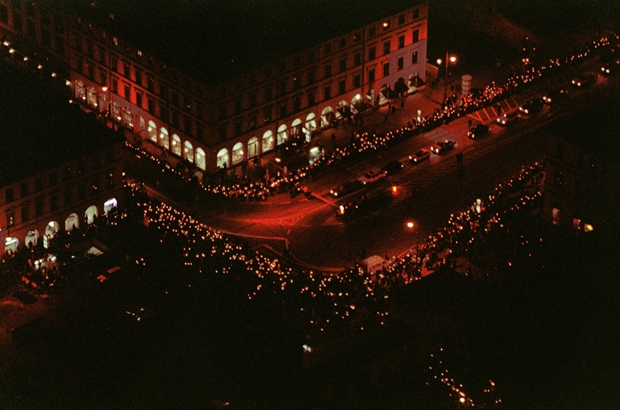Barbara Engels writes about a candle-lit demonstration 20 years ago in Munich set a new benchmark for the power of peaceful protest
It was the biggest protest in Munich since the Second World War. A silent demonstration of peace, love and respect. The demonstration was organized by the young activists Chris Häberlein, Gil Bachrach, Christoph Fisser and Giovanni di Lorenzo. Prominent support was given by German media personalities and of course there were the hundreds of volunteers who made it possible on the night.
Only two choices
On December 6th 1992 more than 400,000 people gathered in Munich. Some were holding candles and others brought flashlights. All were demonstrating peacefully against xenophobia and calling for more tolerance. “It was a real citizen’s movement, bringing light into the dark December,” says Chris Häberlein. “We only had two choices,” reminisces film producer Christoph Fisser, “we could either leave Germany or fight against what was troubling us.”
In 1991 and 1992, far-right violence against migrants had reached a new peak. There were a number of high-profile xenophobic attacks in places throughout Germany like Hoyerswerda in the East, Huenxe in the West and Rostock-Lichtenhagen in the Northeast. “The climate in Germany had changed” explains Fisser. Back in 1992, Gil Bachrach says that he was shocked by the “lethargic reaction of police and politics to the violent far-right mobs.” “We still believed that the majority, who was largely silent about the violent developments, was not in fact far-right”, says Fisser.

On December 6th 1992 more than 400,000 people gathered in Munich. Some were holding candles, others brought flashlights. All were demonstrating peacefully against xenophobia
People had finally enough
When they announced their plans for a rally with some 20,000 or 30,000 participants, they were ridiculed. “They told us that the biggest protest in Munich was the one against the Shops Closing Act with 25,000 protesters,” recalls Fisser. In the end of course the actual attendance exceeded all expectations. Only a few days before the rally, a woman and two children died in a neo-Nazi arson attack on their home in the North German city of Moelln. “People had finally had enough” says Fisser. In the days following the Munich demonstration, several similar demonstrations were organized in cities across Germany with a total attendance of around one million people.
After the protest, the Lichterkette (chain of lights) association, which was only founded to receive donations for the demonstration, found itself with a large amount of money on its books. “It all came in as small donations. 2, 5 or 8 Deutsch Marks [$1-5], so we couldn’t even trace where the money came from.” The initiators of the protests realized that they had to make a long-term project out of the one-time protest. While the idea of the chain of lights spread as a sign of silent protest over the years throughout the world, the original Lichterkette stayed local.
Lichterkette supports
Lichterkette now gives financial, logistic and organizational support to several projects fighting against prejudice and working for the integration of migrants. They also inaugurated the Münchener Lichtblicke (Munich Rays of Hope) award which honors Munich-based initiatives, projects, schools and individuals who are helping Germans and immigrants to live peacefully together.
Another candle-lit demonstration is not being planned any time soon. “Twenty years ago, our campaign was an important sign, but it was also a bit romantic. Today, the problem has to be treated in a systematic and consistent manner,” says Bachrach. And Chris Häberlein warns: “The situation is more dramatic than ever. The inclination towards violence, not only against ‘foreigners’, has risen drastically. Both government and citizens, we all have to show how we can live in peace.”
